
Kemp Town Estate, also known as Kemp Town, is a 19th-century Regency architecture residential estate in the east of Brighton in East Sussex, England. It consists of Arundel Terrace, Lewes Crescent, Sussex Square, Chichester Terrace, and the Kemp Town Enclosures. The estate was conceived and financed by Thomas Read Kemp, designed by Charles Busby and Amon Henry Wilds, and constructed by Thomas Cubitt. Work began in 1823 and it was completed in 1855. It has given its name to the larger Kemptown region of Brighton.

Pimlico is an area of Central London in the City of Westminster, built as a southern extension to neighbouring Belgravia. It is known for its garden squares and distinctive Regency architecture. Pimlico is demarcated to the north by Victoria Station, by the River Thames to the south, Vauxhall Bridge Road to the east and the former Grosvenor Canal to the west. At its heart is a grid of residential streets laid down by the planner Thomas Cubitt, beginning in 1825 and now protected as the Pimlico Conservation Area. The most prestigious are those on garden squares, with buildings decreasing in grandeur away from St George's Square, Warwick Square, Eccleston Square and the main thoroughfares of Belgrave Road and St. George's Drive. Additions have included the pre–World War II Dolphin Square and the Churchill Gardens and Lillington and Longmoore Gardens estates, now conservation areas in their own right. The area has over 350 Grade II listed buildings and several Grade II* listed churches. At the western edge of Pimlico, on the borders of Chelsea, Pimlico Road has become known in recent years for its interiors and design stores.
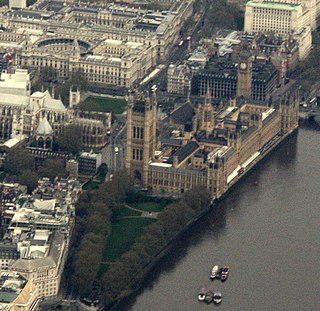
The Parliamentary Estate is the land and buildings used by the Parliament of the United Kingdom.

Belgravia is a district in Central London, covering parts of the areas of the City of Westminster and the Royal Borough of Kensington and Chelsea.

The Worshipful Company of Ironmongers is one of the Great Twelve livery companies of the City of London, incorporated under a Royal Charter in 1463.

Gordon Square is a public park square in Bloomsbury, London, England. It is part of the Bedford Estate and was designed as one of a pair with the nearby Tavistock Square. It is owned by the University of London.

Grosvenor House was one of the largest townhouses in London, home of the Grosvenor family for more than a century. Their original London residence was on Millbank, but after the family had developed their Mayfair estates, they moved to Park Lane to build a house worthy of their wealth, status and influence in the 19th century. The house gave its name to Upper Grosvenor Street and Grosvenor Square.

Woburn Square is the smallest of the Bloomsbury squares and owned by the University of London. Designed by Thomas Cubitt and built between 1829 and 1847, it is named after Woburn Abbey, the main country seat of the Dukes of Bedford, who developed much of Bloomsbury.

The Hilton London Paddington, formerly the Great Western Royal Hotel, is a hotel that forms part of the Paddington Station complex in London, England. The hotel was originally the idea of Isambard Kingdom Brunel, who was the hotel's first managing director. The funding came in large part from the Directors of the Great Western Railway Company, who were persuaded by Brunel to buy shares in the project. The hotel was built on Praed Street in the early 1850s and opened on 9 June 1854 by H.R.H. The Prince Albert, Prince Consort, having taken 14 months to build. The hotel was designed by architect Philip Charles Hardwick, costing approximately £60,000 including all furnishing and fittings - a building which was 'to rival the facilities of the great hotels on the Continent'. The building effectively forms the main façade of the station, closing off the end of the train shed at the head of the terminal platforms. It was built by Messrs Holland Hannen & Cubitts, the building firm founded by Thomas Cubitt.
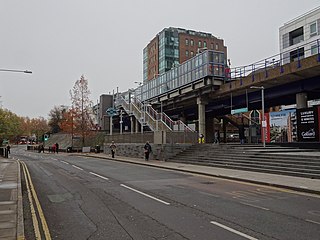
Millwall Docks was a railway station located in the Millwall area of the Isle of Dogs in east London. It was between South Dock and North Greenwich stations on the Millwall Extension Railway (MER) branch of the London and Blackwall Railway (LBR). It opened in December 1871 and was situated on the corner of Glengall Road and East Ferry Road, serving the Millwall Docks.

North Greenwich was a railway station named after the North Greenwich area of the Isle of Dogs in London. It was located on the north side of the River Thames near Island Gardens in the east of the city, and is not to be confused with the present-day North Greenwich station on the London Underground's Jubilee line, which is located on the south side of the river, one mile downstream on the Greenwich Peninsula.
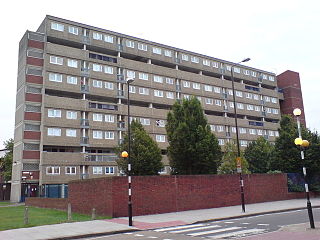
St John's Estate is a housing scheme in Cubitt Town, on the Isle of Dogs in London. Centred on the triangle formed by Manchester Road, East Ferry Road and Glengall Grove, it was developed by Poplar Borough Council after the Second World War. It is served by Crossharbour DLR station to which it is adjacent.

Lillington Gardens is an estate in the Pimlico area of the City of Westminster, London, constructed in phases between 1961 and 1971 to a plan by Darbourne & Darke. The estate was formerly owned and managed by CityWest Homes.

Belgrave Road is a street in the Pimlico area of London. It is situated in the city of Westminster and runs between Eccleston Bridge to the northwest and Lupus Street to the southeast.

St George's Square is a prestigious and very long garden square in affluent Pimlico, Central London. It benefits from gardens and a church in its central area. Near the northern acute angle, the square is intersected by Lupus Street. Pimlico tube station is a short distance east. Its north-east side is in effect Belgrave Road and southern side is arterial Grosvenor Road which is lined by a small public garden in front of the River Thames.
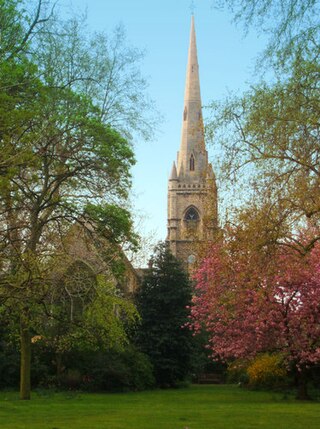
St Gabriel's, Pimlico, is an Anglo-Catholic parish church of the Church of England located in Pimlico, London. It lies within the Deanery of Westminster within the Diocese of London. Designed by Thomas Cundy (junior), it was constructed between 1851 and 1853 as part of Thomas Cubitt's development of the area on behalf of the Marquess of Westminster. It is a Grade II* Listed Building.

St Saviour's is an Anglo-Catholic church in Pimlico, City of Westminster, London, England, located at the north end of St George's Square. It was constructed in the 1860s as part of Thomas Cubitt's development of the area on behalf of the Marquess of Westminster. The church was designed by Thomas Cundy, who had previously built St Gabriel's Pimlico a short distance away. As with St Gabriel's, St Saviour's was designed in the Gothic style and built in ragstone to emphasise the contrast with the classical stucco of its secular neighbours. The church is Grade II listed.
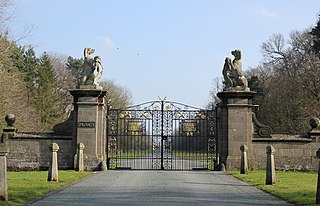
Belgrave is a historic village in Cheshire, England. The area is part of the estates owned the Dukes of Westminster who have their seat at Eaton Hall, Cheshire. The village has a few houses and the Grosvenor Garden Centre. Belgrave Lodge is located at the western end of the 1.7 mi (2.7 km) main approach to Eaton Hall, which is known as the Belgrave Avenue. The name Belgrave is based on the Anglo-Saxon meaning for “beautiful grove”, which Normans replaced after the Conquest from the old name “Medregrave” which in Old French meant “filth grove”.

The Bedford Estate is an estate in central London owned by the Russell family, which holds the peerage title of Duke of Bedford. The estate was originally based in Covent Garden, then stretched to include Bloomsbury in 1669. The Covent Garden property was sold for £2 million in 1913 by Herbrand Russell, 11th Duke of Bedford, to the MP and land speculator Harry Mallaby-Deeley, who sold his option to the Beecham family for £250,000; the sale was finalised in 1918.
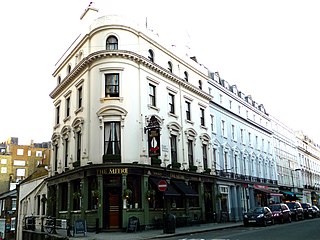
The Mitre is a Grade II listed public house at 24 Craven Terrace, Lancaster Gate, Bayswater, City of Westminster.



















